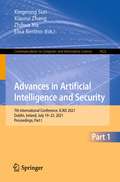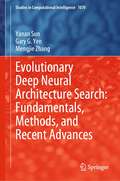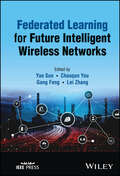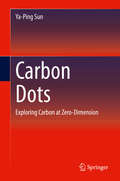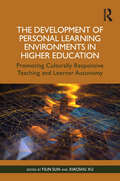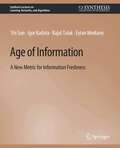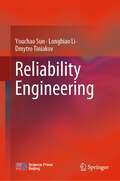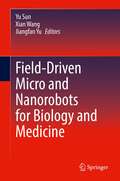- Table View
- List View
Investigations into the Combustion Kinetics of Several Novel Oxygenated Fuels (Springer Theses)
by Wenyu SunIn this thesis, attention was paid to several novel oxygenated fuels—carbonates, polyethers and ketones. Combustion kinetic investigations were performed for typical representative compounds, including dimethyl carbonate, diethyl carbonate, cyclopentanone, 3-pentanone, 1,2-dimethoxyethane and dimethoxymethane. For experiments, suitable diagnostic techniques were used to measure the detailed speciation information of the target fuels under different conditions. For kinetic modeling, rate coefficients for crucial elementary reactions were obtained through high-level theoretical calculations. Based on that, validated kinetic models with good predictive performances were developed. On the basis of experimental measurements and model interpretations, this work highlighted two important combustion characteristics regarding the practical use: the pollutant formation and the ignition performance. Besides, the correlation between oxygen-containing functional groups and the aforementioned combustion characteristics was revealed. To reveal the potential interactions between the reaction networks of oxygenated additives and the hydrocarbon base fuels during combustion. Chemical structures of laminar premixed flames fueled by binary fuels were measured, and by changing the initial fuel compositions, the addition effects of the oxygenates on the fuel consumption and pollutant formation behaviors were explored. It was found that complicated chemical interactions do not exist in the reaction networks under the investigated conditions.
Nanoseparation Using Density Gradient Ultracentrifugation: Mechanism, Methods and Applications (SpringerBriefs in Molecular Science)
by Xiaoming Sun Liang Luo Yun Kuang Pengsong LiThis brief introduces the classification and mechanism of density gradient ultracentrifugation (DGUC) method with rich examples showing the versatility of such an efficient separation technique. It also gives a strict mathematical description and a computational optimization model to predict the best separation parameters for a given colloidal system. The concept of “Lab in a tube” is proposed in the last chapter, which allows the size-property relationship investigation, synthetic optimization and reaction/assembly mechanism exploration etc.
Control and Optimization Based on Network Communication
by Xi-Ming Sun Kun-Zhi Liu Xue-Fang Wang Andrew R. TeelThis book considers the problems of network-based control and optimization. As is known, network-based control has great advantages over traditional control systems because it may lead to easy installation and maintenance, low cost, and so on. Sometimes, network-based control is also necessary in many situations. For example, multi-agents may need to communicate with each other under wireless scenarios. On the other hand, the network may lead to some imperfect factors such as samplings, delays, transmission protocols, and packet losses. These factors may degrade the system performance and even lead to the instability of the control systems.This book aims at providing a modeling framework and analysis approach for the general nonlinear networked control systems based on the hybrid framework. The proposed results deal with very general nonlinear systems and help the readers understand the principle of nonlinear network-based control and optimization.
Artificial Intelligence and Security: 5th International Conference, ICAIS 2019, New York, NY, USA, July 26-28, 2019, Proceedings, Part I (Lecture Notes in Computer Science #11632)
by Xingming Sun Zhaoqing Pan Elisa BertinoThe 4-volume set LNCS 11632 until LNCS 11635 constitutes the refereed proceedings of the 5th International Conference on Artificial Intelligence and Security, ICAIS 2019, which was held in New York, USA, in July 2019. The conference was formerly called “International Conference on Cloud Computing and Security” with the acronym ICCCS.The total of 230 full papers presented in this 4-volume proceedings was carefully reviewed and selected from 1529 submissions. The papers were organized in topical sections as follows: Part I: cloud computing; Part II: artificial intelligence; big data; and cloud computing and security; Part III: cloud computing and security; information hiding; IoT security; multimedia forensics; and encryption and cybersecurity; Part IV: encryption and cybersecurity.
Artificial Intelligence and Security: 5th International Conference, ICAIS 2019, New York, NY, USA, July 26–28, 2019, Proceedings, Part IV (Lecture Notes in Computer Science #11635)
by Xingming Sun Zhaoqing Pan Elisa BertinoThe 4-volume set LNCS 11632 until LNCS 11635 constitutes the refereed proceedings of the 5th International Conference on Artificial Intelligence and Security, ICAIS 2019, which was held in New York, USA, in July 2019. The conference was formerly called “International Conference on Cloud Computing and Security” with the acronym ICCCS.The total of 230 full papers presented in this 4-volume proceedings was carefully reviewed and selected from 1529 submissions. The papers were organized in topical sections as follows: Part I: cloud computing; Part II: artificial intelligence; big data; and cloud computing and security; Part III: cloud computing and security; information hiding; IoT security; multimedia forensics; and encryption and cybersecurity; Part IV: encryption and cybersecurity.
Advances in Artificial Intelligence and Security: 8th International Conference on Artificial Intelligence and Security, ICAIS 2022, Qinghai, China, July 15–20, 2022, Proceedings, Part I (Communications in Computer and Information Science #1586)
by Xingming Sun Xiaorui Zhang Zhihua Xia Elisa BertinoThe 3-volume set CCIS 1586, CCIS 1587 and CCIS 1588 constitutes the refereed proceedings of the 8th International Conference on Artificial Intelligence and Security, ICAIS 2022, which was held in Qinghai, China, in July 2022. The total of 115 full papers and 53 short papers presented in this 3-volume proceedings was carefully reviewed and selected from 1124 submissions. The papers were organized in topical sections as follows:Part I: artificial intelligence;Part II: artificial intelligence; big data; cloud computing and security; multimedia forensics;Part III: encryption and cybersecurity; information hiding; IoT security.
Advances in Artificial Intelligence and Security: 7th International Conference, ICAIS 2021, Dublin, Ireland, July 19-23, 2021, Proceedings, Part I (Communications in Computer and Information Science #1422)
by Xingming Sun Xiaorui Zhang Zhihua Xia Elisa BertinoThe 3-volume set CCIS 1422, CCIS 1423 and CCIS 1424 constitutes the refereed proceedings of the 7th International Conference on Artificial Intelligence and Security, ICAIS 2021, which was held in Dublin, Ireland, in July 2021. The total of 131 full papers and 52 short papers presented in this 3-volume proceedings was carefully reviewed and selected from 1013 submissions. The papers were organized in topical sections as follows:Part I: artificial intelligence;Part II: artificial intelligence; big data; cloud computing and security internet; Part III: cloud computing and security; encryption and cybersecurity; information hiding; IoT security.
Research on the Radiation Effects and Compact Model of SiGe HBT (Springer Theses)
by Yabin SunThis book primarily focuses on the radiation effects and compact model of silicon-germanium (SiGe) heterojunction bipolar transistors (HBTs). It introduces the small-signal equivalent circuit of SiGe HBTs including the distributed effects, and proposes a novel direct analytical extraction technique based on non-linear rational function fitting. It also presents the total dose effects irradiated by gamma rays and heavy ions, as well as the single-event transient induced by pulse laser microbeams. It offers readers essential information on the irradiation effects technique and the SiGe HBTs model using that technique.
Network-Aware Security for Group Communications
by Yan Sun Wade Trappe K. J. LiuThis book aims to fill a growing need in the research community for a reference that describes the state-of-the-art in securing group communications. It focuses on tailoring the security solution to the underlying network architecture (such as the wireless cellular network or the ad hoc/sensor network), or to the application using the security methods (such as multimedia multicasts).
Evolutionary Deep Neural Architecture Search: Fundamentals, Methods, and Recent Advances (Studies in Computational Intelligence #1070)
by Yanan Sun Gary G. Yen Mengjie ZhangThis book systematically narrates the fundamentals, methods, and recent advances of evolutionary deep neural architecture search chapter by chapter. This will provide the target readers with sufficient details learning from scratch. In particular, the method parts are devoted to the architecture search of unsupervised and supervised deep neural networks. The people, who would like to use deep neural networks but have no/limited expertise in manually designing the optimal deep architectures, will be the main audience. This may include the researchers who focus on developing novel evolutionary deep architecture search methods for general tasks, the students who would like to study the knowledge related to evolutionary deep neural architecture search and perform related research in the future, and the practitioners from the fields of computer vision, natural language processing, and others where the deep neural networks have been successfully and largely used in their respective fields.
Series-Parallel Converter-Based Microgrids: System-Level Control and Stability (Power Systems)
by Yao Sun Xiaochao Hou Jinghang Lu Zhangjie Liu Mei Su Joseph M. GuerreroSeries-Parallel Converter-Based Microgrids: System-Level Control and Stability is the first book to provide a comprehensive and in-depth introduction to the rapid development of series-parallel converter applications in the microgrid system. It provides an advanced and in-depth introduction into all major system modeling, coordinated control, and stability analysis issues, and provides useful methodologies and philosophies for developing new topologies and controls for self-organized decentralized operation of microgrid systems. For each topic, a theoretical introduction and overview are backed by very concrete programming examples that enable the reader to not only understand the topic but to develop microgrid simulation models.
Federated Learning for Future Intelligent Wireless Networks
by Yao Sun Chaoqun You Gang Feng Lei ZhangFederated Learning for Future Intelligent Wireless Networks Explore the concepts, algorithms, and applications underlying federated learning In Federated Learning for Future Intelligent Wireless Networks, a team of distinguished researchers deliver a robust and insightful collection of resources covering the foundational concepts and algorithms powering federated learning, as well as explanations of how they can be used in wireless communication systems. The editors have included works that examine how communication resource provision affects federated learning performance, accuracy, convergence, scalability, and security and privacy. Readers will explore a wide range of topics that show how federated learning algorithms, concepts, and design and optimization issues apply to wireless communications. Readers will also find: A thorough introduction to the fundamental concepts and algorithms of federated learning, including horizontal, vertical, and hybrid FL Comprehensive explorations of wireless communication network design and optimization for federated learning Practical discussions of novel federated learning algorithms and frameworks for future wireless networks Expansive case studies in edge intelligence, autonomous driving, IoT, MEC, blockchain, and content caching and distribution Perfect for electrical and computer science engineers, researchers, professors, and postgraduate students with an interest in machine learning, Federated Learning for Future Intelligent Wireless Networks will also benefit regulators and institutional actors responsible for overseeing and making policy in the area of artificial intelligence.
Carbon Dots: Exploring Carbon at Zero-Dimension
by Ya-Ping SunWritten by the founder of the field of carbon “quantum” dots (carbon dots) and related technology, this book outlines the principles of carbon dots and presents strong evidence for that small carbon nanoparticles and by extension carbon dots represent the nanoscale carbon allotrope at zero-dimension. Historical accounts of the inception and evolution of the carbon dots field are provided. Experimental approaches and techniques for the dot synthesis and some related major issues are discussed in detail. The photoexcited state properties, especially the bright and colorful photoluminescence emissions, and photoinduced redox characteristics of carbon dots are presented, and so are their advantages over semiconductor quantum dots as well as fullerenes. Carbon dots are also compared with “graphene quantum dots”, for which a unified mechanistic understanding is proposed. Finally, a broad range of applications of carbon dots and their derived hybrid nanostructures in biomedical, renewable energy, food and environmental safety, and other technologies are highlighted. The book concludes with a discussion on the excellent potential and opportunities for further research and development.
The Development of Personal Learning Environments in Higher Education: Promoting Culturally Responsive Teaching and Learner Autonomy
by Yilin Sun Xiaoshu XuThe Development of Personal Learning Environments in Higher Education explores how today’s knowledge-based, learner-centered virtual platforms, which often limit teaching to a complimentary facilitation role, can compromise with the requirements and regulations of colleges and universities. Personal Learning Environments (PLEs) driven by culturally responsive teaching and learner autonomy represent a shift in the higher education paradigm, but how can scholars, designers, administrators, and faculty ensure effective, institutionally compatible construction and management of these systems? This book offers forward-thinking insights into the variety of student-centered learning interactions, particularly culturally and linguistically responsive pedagogies, that can be integrated into PLEs. Attending to quality assessment rubrics, the nuances of stakeholders’ needs, and theoretically sound frameworks, these cross-cultural, interdisciplinary chapters explore how leaders, instructors, technologists, and learners can form a precise yet flexible ecosystem to fully realize PLEs in which co-created, intercultural narratives yield rich, relevant digital learning experiences.
Age of Information: A New Metric for Information Freshness (Synthesis Lectures on Learning, Networks, and Algorithms)
by Yin Sun Igor Kadota Rajat Talak Eytan ModianoInformation usually has the highest value when it is fresh. For example, real-time knowledge about the location, orientation, and speed of motor vehicles is imperative in autonomous driving, and the access to timely information about stock prices and interest rate movements is essential for developing trading strategies on the stock market. The Age of Information (AoI) concept, together with its recent extensions, provides a means of quantifying the freshness of information and an opportunity to improve the performance of real-time systems and networks. Recent research advances on AoI suggest that many well-known design principles of traditional data networks (for, e.g., providing high throughput and low delay) need to be re-examined for enhancing information freshness in rapidly emerging real-time applications. This book provides a suite of analytical tools and insightful results on the generation of information-update packets at the source nodes and the design of network protocols forwarding the packets to their destinations. The book also points out interesting connections between AoI concept and information theory, signal processing, and control theory, which are worthy of future investigation.
Strain Effect in Semiconductors: Theory and Device Applications
by Yongke Sun Scott E. Thompson Toshikazu NishidaStrain Effect in Semiconductors: Theory and Device Applications presents the fundamentals and applications of strain in semiconductors and semiconductor devices that is relevant for strain-enhanced advanced CMOS technology and strain-based piezoresistive MEMS transducers. Discusses relevant applications of strain while also focusing on the fundamental physics pertaining to bulk, planar, and scaled nano-devices. Hence, this book is relevant for current strained Si logic technology as well as for understanding the physics and scaling for future strained nano-scale devices.
Reliability Engineering
by Youchao Sun Longbiao Li Dmytro TiniakovThis textbook covers the fundamentals of reliability theory and its application for engineering processes, especially for aircraft units and systems. Reliability basis was explained for the best understanding of reliability analysis application for engineering systems in aviation industry. Several approaches for the reliability analysis and their application with examples are presented. It also introduces main trends in the modern reliability theory development.This book will be interested for university students and early-career engineers of aviation industry majors.
New Development in Robot Vision (Cognitive Systems Monographs #23)
by Yu Sun Aman Behal Chi-Kit Ronald ChungThe field of robotic vision has advanced dramatically recently with the development of new range sensors. Tremendous progress has been made resulting in significant impact on areas such as robotic navigation, scene/environment understanding, and visual learning. This edited book provides a solid and diversified reference source for some of the most recent important advancements in the field of robotic vision. The book starts with articles that describe new techniques to understand scenes from 2D/3D data such as estimation of planar structures, recognition of multiple objects in the scene using different kinds of features as well as their spatial and semantic relationships, generation of 3D object models, approach to recognize partially occluded objects, etc. Novel techniques are introduced to improve 3D perception accuracy with other sensors such as a gyroscope, positioning accuracy with a visual servoing based alignment strategy for microassembly, and increasing object recognition reliability using related manipulation motion models. For autonomous robot navigation, different vision-based localization and tracking strategies and algorithms are discussed. New approaches using probabilistic analysis for robot navigation, online learning of vision-based robot control, and 3D motion estimation via intensity differences from a monocular camera are described. This collection will be beneficial to graduate students, researchers, and professionals working in the area of robotic vision.
Field-Driven Micro and Nanorobots for Biology and Medicine
by Yu Sun Xian Wang Jiangfan YuThis book describes the substantial progress recently made in the development of micro and nanorobotic systems, utilizing magnetic, optical, acoustic, electrical, and other actuation fields. It covers several areas of micro and nanorobotics including robotics, materials science, and biomedical engineering. Field-Driven Micro and Nanorobots for Biology and Medicine provides readers with fundamental physics at the micro and nano scales, state-of-the-art technical advances in field-driven micro and nanorobots, and applications in biological and biomedical disciplines.
Advances in Power and Energy Engineering: Proceedings of the 8th Asia-Pacific Power and Energy Engineering Conference, Suzhou, China, April 15-17, 2016
by Yuanzhang SunEnergy and power are playing pivotal roles in social and economic developments of the modern world. Energy and power engineers and technologists have made our lives much more comfortable and affordable. However, due to the demands of the global population on resources and the environment, innovations of more reliable and sustainable energy res
Secure and Trustworthy Transportation Cyber-Physical Systems (SpringerBriefs in Computer Science)
by Yunchuan Sun Houbing SongThis book comprehensively reviews the cyber security and privacy issues in transportation cyber-physical systems (TCPSs). It examines theories and various state-of-the-art technologies and methodologies. Starting with a survey of the latest solutions in TCPSs, it introduces a smart-transport-system architecture design based on cyber-physical systems. It then discusses in detail the principles and metrics of evaluating safety and privacy in TCPSs and elaborates the verification and analysis of secure, robust and trustworthy TCPSs. Moreover, it demonstrates the advanced and novel tools commonly used in practice by several researchers. Lastly it provides an exhaustive case study on the authentication and attestation in TCPSs. This book is of interest not only to readers in the field of TCPSs, but also to those in interdisciplinary fields, such as energy, healthcare, bio-engineering etc.
Technologies for Deep Space Exploration (Space Science and Technologies)
by Zezhou SunThis book offers readers essential insights into system design for deep space probes and describes key aspects such as system design, orbit design, telecommunication, GNC, thermal control, propulsion, aerobraking and scientific payload. Each chapter includes the basic principles, requirements analysis, procedures, equations and diagrams, as well as practical examples that will help readers to understand the research on each technology and the major concerns when it comes to developing deep space probes. An excellent reference resource for researchers and engineers interested in deep space exploration, it can also serve as a textbook for university students and those at institutes involved in aerospace.
Intelligent Techniques in E-Commerce: A Case Based Reasoning Perspective (Studies in Fuzziness and Soft Computing #144)
by Zhaohao Sun Gavin R. FinnieE-commerce has passed through a number of stages in the minds of most readers of the daily press. Initially it was the province of the specialist and considered almost irrelevant to the needs and activities of everyday life - companies looking for venture capital in this area had little if any chance of obtaining sufficient funds from the rather conservative investors who provided the only source of start-up capital. Then came the dot. com boom -and suddenly e-commerce was the most exciting topic possible! Venture capital was available from every possible source and almost any company with a . com in its name could be assured of instant funding on request. This boom was, inevitably, followed by the dot. com bust and the press wamed that the days of e-commerce were gone, perhaps never to return. This apparently confusing 'stages of growth' model is in reality nothing ofthe sort. E-commerce is simply the logical outcome of combining computers with tele communications networks. The astonishing changes which a global economy has brought with it are reflected in the changes to the way we do business which are increasingly synonymous with e-commerce. Indeed, the term e-commerce itself is coming to mean only the transaction-based component of e-business-'any process that a business organisation conducts over a computer-mediated network' as Thomas Mesenbourg ofthe U. S. Census Bureau said in 1999.
Switched Linear Systems: Control and Design (Communications and Control Engineering)
by Zhendong SunSwitched linear systems have enjoyed a particular growth in interest since the 1990s. The large amount of data and ideas thus generated have, until now, lacked a co-ordinating framework to focus them effectively on some of the fundamental issues such as the problems of robust stabilizing switching design, feedback stabilization and optimal switching. This deficiency is resolved by this book which features: nucleus of constructive design approaches based on canonical decomposition and forming a sound basis for the systematic treatment of secondary results; theoretical exploration and logical association of several independent but pivotal concerns in control design as they pertain to switched linear systems: controllability and observability, feedback stabilization, optimization and periodic switching; a reliable foundation for further theoretical research as well as design guidance for real life engineering applications through the integration of novel ideas, fresh insights and rigorous results.
Stability Theory of Switched Dynamical Systems (Communications and Control Engineering)
by Zhendong Sun Shuzhi Sam GeThere are plenty of challenging and interesting problems open for investigation in the field of switched systems. Stability issues help to generate many complex nonlinear dynamic behaviors within switched systems. The authors present a thorough investigation of stability effects on three broad classes of switching mechanism: arbitrary switching where stability represents robustness to unpredictable and undesirable perturbation, constrained switching, including random (within a known stochastic distribution), dwell-time (with a known minimum duration for each subsystem) and autonomously-generated (with a pre-assigned mechanism) switching; and designed switching in which a measurable and freely-assigned switching mechanism contributes to stability by acting as a control input.For each of these classes this book propounds: detailed stability analysis and/or design, related robustness and performance issues, connections to other control problems and many motivating and illustrative examples.






